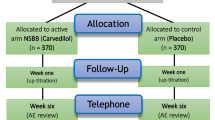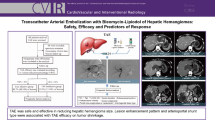Abstract
Background
Bevacizumab inhibits vascular endothelial growth factor-A (VEGF-A), though is known to increase bleeding risk as an adverse event (AE). This study examined whether atezolizumab/bevacizumab (Atez/Bev) for unresectable hepatocellular carcinoma (uHCC) can be used for patients with esophageal–gastric varices (EGV).
Methods
From October 2020 to December 2022, 506 uHCC patients (median 74 years) underwent an upper gastrointestinal endoscopy examination were enrolled, after exclusion of those with portal vein tumor thrombus (PVTT). Patients with EGV (≧ F1) were defined as EGV positive, and the cohort was divided into non-EGV (n = 355) and EGV (n = 151). Before introducing Atez/Bev, endoscopic treatment was performed, when necessary. Prognosis was evaluated, retrospectively.
Results
The EGV group had significantly worse hepatic function, lower platelet count, elevated alpha-fetoprotein, and lower rate of extrahepatic metastasis, and lower rate of first-line use (each P < 0.05) than the other. However, progression-free survival (PFS) was also not a significantly difference between the EGV and non-EGV groups in analyses with (PFS rate at 6/12/18 months: 60%/38%/30% vs. 65%/46%/34%, P = 0.29) or without inverse probability weighting adjustment [median: 10.6 months (95% CI 8.3–14.0) vs. 10.5 months (95% CI 7.8–13.7), P = 0.79]. As for AEs, diarrhea was more frequent in the EGV group (≧ G3: 2.0% vs. 0.3%, P = 0.036), while no significant difference was noted for EGV hemorrhage (≧ G3: 1.3% vs. 0.6%, P = 0.345). Of 28 patients who underwent endoscopic treatments before introducing Atez/Bev, none showed EGV-associated hemorrhage.
Conclusions
Atez/Bev might be an effective therapeutic option in patients with EGV, when appropriate endoscopic treatment for EGV is performed.


Similar content being viewed by others
Data availability
Due to the nature of this research, the participants could not be contacted regarding whether the findings could be shared publicly, and thus, supporting data, including datasets generated and/or analyzed for the current study, are not publicly available.
References
Bray F, Ferlay J, Soerjomataram I, et al. Global cancer statistics 2018: GLOBOCAN estimates of incidence and mortality worldwide for 36 cancers in 185 countries. CA Cancer J Clin. 2018;68:394–424.
Arnold M, Abnet CC, Neale RE, et al. Global burden of 5 major types of gastrointestinal cancer. Gastroenterology. 2020;159(335–49): e15.
Vogel A, Meyer T, Sapisochin G, et al. Hepatocellular carcinoma. Lancet. 2022;400:1345–62.
Llovet JM, Ricci S, Mazzaferro V, et al. Sorafenib in advanced hepatocellular carcinoma. N Engl J Med. 2008;359:378–90.
Kudo M, Finn RS, Qin S, et al. Lenvatinib versus sorafenib in first-line treatment of patients with unresectable hepatocellular carcinoma: a randomised phase 3 non-inferiority trial. Lancet. 2018;391:1163–73.
Bruix J, Qin S, Merle P, et al. Regorafenib for patients with hepatocellular carcinoma who progressed on sorafenib treatment (RESORCE): a randomised, double-blind, placebo-controlled, phase 3 trial. Lancet. 2017;389:56–66.
Zhu AX, Finn RS, Galle PR, et al. Ramucirumab in advanced hepatocellular carcinoma in REACH-2: the true value of alpha-fetoprotein. Lancet Oncol. 2019;20: e191.
Kudo M, Tsuchiya K, Kato N, et al. Cabozantinib in Japanese patients with advanced hepatocellular carcinoma: a phase 2 multicenter study. J Gastroenterol. 2021;56:181–90.
Finn RS, Qin S, Ikeda M, et al. Atezolizumab plus Bevacizumab in unresectable hepatocellular carcinoma. N Engl J Med. 2020;382:1894–905.
Chuma M, Uojima H, Hattori N, et al. Safety and efficacy of atezolizumab plus bevacizumab in patients with unresectable hepatocellular carcinoma in early clinical practice: a multicenter analysis. Hepatol Res. 2022;52:269–80.
Hiraoka A, Kumada T, Tada T, et al. Early experience of atezolizumab plus bevacizumab treatment for unresectable hepatocellular carcinoma BCLC-B stage patients classified as beyond up to seven criteria - multicenter analysis. Hepatol Res. 2022;52:308–16.
Maesaka K, Sakamori R, Yamada R, et al. Comparison of atezolizumab plus bevacizumab and lenvatinib in terms of efficacy and safety as primary systemic chemotherapy for hepatocellular carcinoma. Hepatol Res. 2022;52:630–40.
Tajiri T, Yoshida H, Obara K, et al. General rules for recording endoscopic findings of esophagogastric varices (2nd edition). Dig Endosc. 2010;22:1–9.
The Japan Society for Portal Hypertension. Clinical manual of portal hypertension: diagnosis and treatment of esophageal and gastric varices. Tokyo: Nankodo; 2015. p. 50–4.
Krige JE, Shaw JM, Bornman PC. The evolving role of endoscopic treatment for bleeding esophageal varices. World J Surg. 2005;29:966–73.
Yoshiji H, Nagoshi S, Akahane T, et al. Evidence-based clinical practice guidelines for liver cirrhosis 2020. J Gastroenterol. 2021;56:593–619.
European Association for the Study of the Liver. EASL clinical practical guidelines: management of alcoholic liver disease. J Hepatol. 2012;57:399–420.
Mittal S, El-Serag HB. Epidemiology of hepatocellular carcinoma: consider the population. J Clin Gastroenterol. 2013;47(Suppl):S2-6.
Pugh RN, Murray-Lyon IM, Dawson JL, et al. Transection of the oesophagus for bleeding oesophageal varices. Br J Surg. 1973;60:646–9.
Johnson PJ, Berhane S, Kagebayashi C, et al. Assessment of liver function in patients with hepatocellular carcinoma: a new evidence-based approach-the ALBI grade. J Clin Oncol. 2015;33:550–8.
Hiraoka A, Kumada T, Michitaka K, et al. Usefulness of albumin-bilirubin grade for evaluation of prognosis of 2584 Japanese patients with hepatocellular carcinoma. J Gastroenterol Hepatol. 2016;31:1031–6.
Hiraoka A, Michitaka K, Kumada T, et al. Validation and potential of albumin-bilirubin grade and prognostication in a nationwide survey of 46,681 hepatocellular carcinoma patients in Japan: the need for a more detailed evaluation of hepatic function. Liver Cancer. 2017;6:325–36.
Bruix J, Sherman M. Practice Guidelines Committee AAftSoLD management of hepatocellular carcinoma. Hepatology. 2005;42:1208–36.
Di Martino M, Marin D, Guerrisi A, et al. Intraindividual comparison of gadoxetate disodium-enhanced MR imaging and 64-section multidetector CT in the detection of hepatocellular carcinoma in patients with cirrhosis. Radiology. 2010;256:806–16.
Sano K, Ichikawa T, Motosugi U, et al. Imaging study of early hepatocellular carcinoma: usefulness of gadoxetic acid-enhanced MR imaging. Radiology. 2011;261:834–44.
Reig M, Forner A, Rimola J, et al. BCLC strategy for prognosis prediction and treatment recommendation: the 2022 update. J Hepatol. 2022;76:681–93.
Institute NC. Common Terminology Criteria for Adverse Events (CTCAE) v5.0. https://ctep.cancer.gov/protocolDevelopment/electronic_applications/ctc.htm#ctc_50. Accessed 7 Mar 2023.
Eisenhauer EA, Therasse P, Bogaerts J, et al. New response evaluation criteria in solid tumours: revised RECIST guideline (version 1.1). Eur J Cancer. 2009;45:228–47.
Lencioni R, Llovet JM. Modified RECIST (mRECIST) assessment for hepatocellular carcinoma. Semin Liver Dis. 2010;30:52–60.
Kanda Y. Investigation of the freely available easy-to-use software “EZR” for medical statistics. Bone Marrow Transplant. 2013;48:452–8.
European Association for the Study of the Liver. Electronic address eee, European Association for the Study of the L. EASL Clinical Practice Guidelines: Management of hepatocellular carcinoma. J Hepatol. 2018;69:182–236.
Li X, Feng GS, Zheng CS, et al. Expression of plasma vascular endothelial growth factor in patients with hepatocellular carcinoma and effect of transcatheter arterial chemoembolization therapy on plasma vascular endothelial growth factor level. World J Gastroenterol. 2004;10:2878–82.
Mukozu T, Nagai H, Matsui D, et al. Serum VEGF as a tumor marker in patients with HCV-related liver cirrhosis and hepatocellular carcinoma. Anticancer Res. 2013;33:1013–21.
Fernandez M. Molecular pathophysiology of portal hypertension. Hepatology. 2015;61:1406–15.
Nakayama H, Masuda H, Miyake H, et al. Endoscopic prediction of hepatocellular carcinoma by evaluation of bleeding esophageal varices. Digestion. 2004;70:233–9.
Ripoll C, Groszmann RJ, Garcia-Tsao G, et al. Hepatic venous pressure gradient predicts development of hepatocellular carcinoma independently of severity of cirrhosis. J Hepatol. 2009;50:923–8.
Ishikawa T, Egusa M, Fujioka T, et al. A combination of liver stiffness and international normalized ratio is an ideal prognostic predictor of portosystemic shunt occlusion in patients with portal hypertension. J Gastroenterol. 2023;58:246–56.
Tanaka T, Hiraoka A, Tada T, et al. Therapeutic efficacy of atezolizumab plus bevacizumab treatment for unresectable hepatocellular carcinoma in patients with Child-Pugh class A or B liver function in real-world clinical practice. Hepatol Res. 2022;52:773–83.
Tateishi R, Matsumura T, Okanoue T, et al. Hepatocellular carcinoma development in diabetic patients: a nationwide survey in Japan. J Gastroenterol. 2021;56:261–73.
Tokushige K, Ikejima K, Ono M, et al. Evidence-based clinical practice guidelines for nonalcoholic fatty liver disease/nonalcoholic steatohepatitis 2020. Hepatol Res. 2021;51:1013–25.
Garcia-Tsao G, Wiest R. Gut microflora in the pathogenesis of the complications of cirrhosis. Best Pract Res Clin Gastroenterol. 2004;18:353–72.
Simbrunner B, Mandorfer M, Trauner M, et al. Gut-liver axis signaling in portal hypertension. World J Gastroenterol. 2019;25:5897–917.
Su GL, Altayar O, O’Shea R, et al. AGA clinical practice guideline on systemic therapy for hepatocellular carcinoma. Gastroenterology. 2022;162:920–34.
Abou-Alfa GK, Lau G, Kudo M, et al. Tremelimumab plus durvalumab in unresectable hepatocellular carcinoma. NEJM Evid. 2022;1:EVIDoa2100070.
Llovet JM, Pinyol R, Kelley RK, et al. Molecular pathogenesis and systemic therapies for hepatocellular carcinoma. Nat Cancer. 2022;3:386–401.
Bejjani AC, Finn RS. Hepatocellular carcinoma: pick the winner-tyrosine kinase inhibitor versus immuno-oncology agent-based combinations. J Clin Oncol. 2022;40:2763–73.
Iavarone M, Primignani M, Vavassori S, et al. Determinants of esophageal varices bleeding in patients with advanced hepatocellular carcinoma treated with sorafenib. United Eur Gastroenterol J. 2016;4:363–70.
Breder VV, Vogel A, Merle A, et al. IMbrave150: exploratory efficacy and safety results of hepatocellular carcinoma (HCC) patients (pts) with main trunk and/or contralateral portal vein invasion (Vp4) treated with atezolizumab (atezo) + bevacizumab (bev) versus sorafenib (sor) in a global Ph III study. J Clin Oncol 2021;39(15_suppl):4073.
Funding
None to declare.
Author information
Authors and Affiliations
Consortia
Contributions
AH and TK conceived the study, and participated in its design and coordination. AH, TT, MH, KK, JT, MA, KT, EI, SF, KT, TI, KT, HO, SY, HT, CO, TN, TH, SK, NS, KK, AN, HK, TM, HK, YY, HO, FT, KN, AM, AT, TN, NI, TO, TA, KY, HN, MI, YK, SN, HI, MK, YH, and TK performed data curation. FT and AH performed statistical analyses and interpretation. FT and AH drafted the text. All authors have read and approved the final version of the manuscript.
Corresponding author
Ethics declarations
Conflict of interest
Atsushi Hiraoka, MD, PhD: lecture fees; Chugai, Bayer, and Eli Lilly. Takashi Kumada, MD, PhD: lecture fees; Eisai. Toshifumi Tada MD, PhD: AbbVie, Eisai, and Chugai. Takeshi Hatanaka MD, PhD: Eisai. None of the other authors have potential conflicts of interest to declare.
Ethical approval
The entire study protocol was approved by the Institutional Ethics Committee of Ehime Prefectural Central Hospital (No. 2022-46). After receiving official approval, this study was conducted as a retrospective analysis of database records based on the Guidelines for Clinical Research issued by the Ministry of Health and Welfare of Japan. All procedures were done in accordance with the Declaration of Helsinki. The data were made anonymous before analysis to protect patient privacy. Written informed consent was obtained from all patients before treatment and this study received ethical approval for use of an opt-out methodology based on low risk to the participants.
Additional information
Publisher's Note
Springer Nature remains neutral with regard to jurisdictional claims in published maps and institutional affiliations.
Supplementary Information
Below is the link to the electronic supplementary material.
Rights and permissions
Springer Nature or its licensor (e.g. a society or other partner) holds exclusive rights to this article under a publishing agreement with the author(s) or other rightsholder(s); author self-archiving of the accepted manuscript version of this article is solely governed by the terms of such publishing agreement and applicable law.
About this article
Cite this article
Tada, F., Hiraoka, A., Tada, T. et al. Efficacy and safety of atezolizumab plus bevacizumab treatment for unresectable hepatocellular carcinoma patients with esophageal–gastric varices. J Gastroenterol 58, 1134–1143 (2023). https://doi.org/10.1007/s00535-023-02026-2
Received:
Accepted:
Published:
Issue Date:
DOI: https://doi.org/10.1007/s00535-023-02026-2




